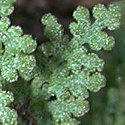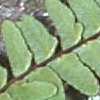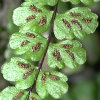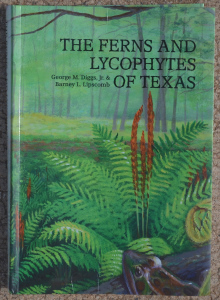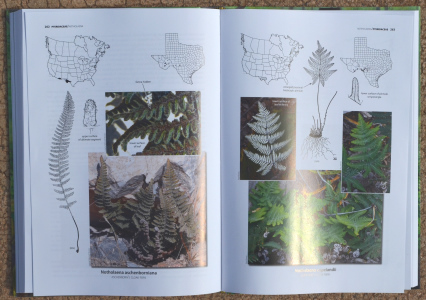| Family DRYOPTERIDACEAE: Wood Ferns Typically "fernlike", northern. Four near-xerophyte species in one genus in southern AZ. | |
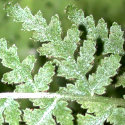 |
Woodsia
cochisensis Leaves light green, bipinnate, pinnae toothed and blunt pointed, with slightly thickened margins. Indusia are broad and scalelike. Damp, shady rock ledges on granite or volcanics, southeastern AZ. SIMILAR SPECIES: W. plummerae (not shown) has sticky leaves that may be forked at the tip. |
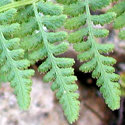 |
Woodsia
phillipsii Leaves light green, bipinnate, pinnae long and pointed, with thickened margins and cilia (tiny transparent "fringes") on toothed edges. Indusia (partial coverings on sori) are narrow and fringelike. Damp, shady rock ledges on granite or volcanics, southeastern AZ. SIMILAR SPECIES: Other Woodsia do not have cilia on leaf edges or fringelike indusia. They have fewer pinnules and the pinnae are blunt, not elongate. |
| POLYPODIACEAE: Polypody Ferns Humid temperate/tropical. Two near-xerophyte species in two genera in southern AZ. | |
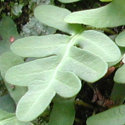 |
Pleopeltis riograndensis
Rio Grande Scaly Polypody Leaves pinnatifid, shining bright green when wet, curled and grayish-brown when dry, hygroscopic. Leaflets rounded to slightly pointed, with scattered brownish scales on the underside. On shaded, mossy rocks in Madrean evergreen woodland, southeastern AZ. SIMILAR SPECIES: Polypodium hesperium is larger and lacks scales on the underside. |
| Family PTERIDACEAE: True Ferns Large, diverse family of true xerophytes. 36 species in seven genera in southern AZ. | |
 |
PELLAEA
Cliffbrakes Leaves grayish green to bluish green with dark wiry stems. Leaflets smooth, leathery, paler green underneath and without hair, scales, or white coating. Leaflets on fertile leaves are distinctly smaller than those on sterile leaves, with edges rolled under to cover spores. Lower part of leaf is usually bipinnate, tip is pinnate. Sun or part shade among granite boulders and outcrops. Some species are also found on limestone. SIMILAR GENERA: Argyrochosma has more crowded leaflets that have a white coating on the underside. |
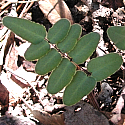 |
Pellaea
atropurpurea Purple-stemmed Cliffbrake Triangular leaf with purplish-black stem. Leaflets relatively few and large, long oval to blunt triangular. Sterile fronds have broader leaflets than fertile fronds. Widely distributed in the U.S. but uncommon. SIMILAR SPECIES: Other Pellaea have smaller, more uniform leaflets. PHOTO:Pellaea atropurpurea (sterile and fertile leaflets) growing with Asplenium resliens. P. lyngholmii (central AZ) is a hybrid between P. atropurpurea and P. truncata. |
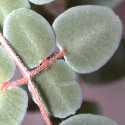 |
Pellaea intermedia
Creeping Cliffbrake Triangular grayish green leaf with pale brown to gray stem. Leaflets flat, oval to nearly circular, without spines at tips. Partial shade on limestone or granite. SIMILAR SPECIES: Identify by round, coinlike leaflets and light-colored stem. Sterile leaves of P. truncata may look similar, but stems are dark and leaflets are typically more elongate and/or wavy-edged, with small spines at tips. |
 |
Pellaea truncata Spiny
Cliffbrake Leaves erect, tightly clustered, shrubby, grayish green, triangular, tripinnate near base, pinnate near tip. The pinnate leaflets may be missing on older leaves, leaving the stem tip bare. Leaflets oval, broad on sterile leaves and narrow on fertile leaves, with a tiny spine at the tip of each leaflet. Most common Pellaea in our area. On granite and rhyolite. SIMILAR SPECIES: Identify by oval spine-tipped leaflets. P. intermedia has round leaflets without spines. 1931 SE AZ records of P. mucronata, a similar California species, may be misidentifications. |
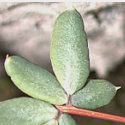 |
Pellaea
ternifolia Birdfoot Cliffbrake |
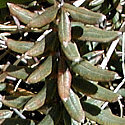 |
Pellaea
wrightiana Hybrid between P. ternifolia & P. truncata
Leaves dark green to bluish green, long and narrow, with shining purple stem. Similar to P. ternifolia but leaflets are longer and narrower, the lower leaflets form clusters of five or more (truly bipinnate, not just ternate) and plants may be larger and taller, like the robust, shrubby examples in the photo. Full sun, granite and rhyolite. PHOTO: Pellaea wrightiana with Cheilanthes lindheimeri & Bommeria hispida. SIMILAR SPECIES: P. ternifolia, P. villosa |
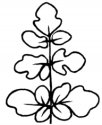 |
ARGYROCHOSMA
Silver Ferns Leaves smooth, hairless, triangular or teardrop-shaped. Stems smooth or slightly downy, dark and wiry. Leaflets 2-5 pinnate; undersides may have a white waxy or mealy coating. Segments at tips of leaflets are stalked and entire. Sori are scattered in thin lines parallel to the edge of the leaflet. SIMILAR GENERA: Pellaea is green underneath and leaflet shapes are different. Notholaena terminal segments are stalkless and pinnatifid. |
| Photo
from Mexican botanist Carlos Velazco HERE. |
*Argyrochosma
incana Small, lacy. Leaflets lobed, margins not inrolled. Shady places at the base of granite or rhyolite boulders, a few localities in southeastern AZ. Several known sites have burned or sustained other damage since 2006. SIMILAR SPECIES: A. limitanea has smaller, more numerous leaflets that are oval, not lobed, and is more widespread in distribution. A. jonesii has larger leaflets and its range does not overlap with A. incana. |
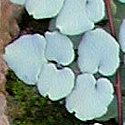 |
Argyrochosma
jonesii Leaves bluish-green, triangular, bipinnate (basal leaflets may be tripinnate), with thin black stems. Leaflets stalked, triangular or heart-shaped with lobes at the base, relatively large (to 1 cm). Damp, shady, protected hollows in limestone outcrops. Central, western, and northern AZ; one outlier in Sonoran Desert. SIMILAR SPECIES: The relatively large heart-shaped leaflets are distinctive. |
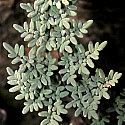 |
Argyrochosma limitanea
ssp. limitanea Leaves up to 4 or 5-pinnate, triangular to pointed-oval. Leaflets minute, bluish green (gray or pale tan when dry), long oval, waxy white underneath. Stems are longer than the leaves. Shady cracks in any kind of rock, usually under a tree or shrub. Nearly throughout AZ. SIMILAR SPECIES: A. limitanea ssp. mexicana is restricted to extreme southeast AZ and has smaller, narrower leaves with fewer and slightly larger leaflets. |
 |
ASTROLEPIS
Scaly Cloak Ferns Leaves pinnate, dark green, long and narrow. Leaflets have tiny white star-shaped scales on the upper surface and fringed white to brownish ribbonlike scales on the lower surface. Sori are often clustered between lobes. Full sun on rocky slopes or ridgetops. The most sun-tolerant of the xerophytic ferns. SIMILAR GENERA: Both types of leaflet scales are unique to this genus. In our area, the narrow, pinnate leaves are also distinctive. |
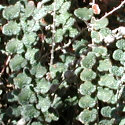 |
*Astrolepis
cochisensis ssp. arizonica Cochise Cloak Fern, Narrow
Cloak Fern Very narrow bluish or grayish green leaves in arched, open sprays. Leaflets oval to nearly circular, 0-3 shallow lobes. Upper surface speckled with persistent white scales. Small felted brown-dotted white scales on underside. Sun to part shade on weathered granite or feldspar-rich volcanics. FNA lists two AZ subspecies based on spore size and substrate: subsp. arizonica (granite & volcanics); subsp. cochisensis (limestone). SIMILAR SPECIES: In the field, the two subspecies differ in substrate and very slightly in growth habit. Other Astrolepis have larger leaflets that are more obviously lobed. |
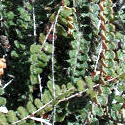 |
Astrolepis
cochisensis ssp. cochisensis Very narrow leaves in tight, erect, shrublike clusters. Leaves very dark green, appearing almost black in bright sunlight, grayish brown when dry. Leaflets oval to nearly circular, 0-3 very shallow lobes. Upper surface speckled with persistent white scales. Small felted brown-dotted white scales on underside. Full sun on limestone or marble slopes and ridgetops; often abundant. One of our most drought-tolerant ferns. PHOTO:A. cochisensis ssp. cochisensis on limestone hilltop with Encelia farinosa, endangered Echinocactus horizonthalonius var. nichollii, and Agave deserti var. simplex. |
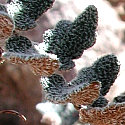 |
Astrolepis
integerrima Leaves erect, tightly clustered to slightly spreading, bright green to dark green, pale tan when dry. Leaflets variable in shape, even on a single leaf, and may be oval, elongate, or triangular. They have several shallow, uneven lobes. Dense, soft silvery-white scales cover the upper surface, even on older leaves. Shaggy overlapping light brown scales cover the underside. On limestone, full sun or part shade, solitary or in small groups. SIMILAR SPECIES: This species has the most irregular leaves and the largest scales of any Astrolepis. |
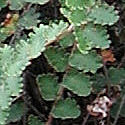 |
Astrolepis
sinuata Wavy Scaly Cloak Fern Leaves large, robust, arched or spreading. Bright green, cinnamon brown when dry. Leaflets have seven or more distinct rounded lobes that are all the same size and shape. Young leaflets are dotted with white scales on the upper surface, white to tan or brownish scales on underside. Older leaflets have few or no scales on top. Full sun to part shade, reaches its largest size on limestone but also grows on other rock types. SIMILAR SPECIES: This common fern is the largest Astrolepis, with the largest, most complex, and most distinctly lobed leaflets. |
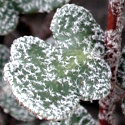 |
Astrolepis
windhamii Leaves erect, tightly clustered, dark green, purplish brown when dry. Leaflets triangular to oval, with several shallow lobes, often with one or two more prominent lobes at the leaflet base. Upper side dusted with tiny white scales that are often absent on old leaflets. Scales on underside are shaggy white with brown streaks. Full sun. Usually on limestone, occasionally on shale, siltstone, or mica schist. SIMILAR SPECIES: A. sinuata has more and larger lobes on the leaflets. A. integerrima has more elongate leaflets, and larger, more persistent scales. A. cochisensis has smaller, rounder leaflets with fewer lobes. |
 |
CHEILANTHES
Cloak Ferns or Lip Ferns Largest
and most diverse genus of xerophytic ferns. Triangular bipinnate
or tripinnate leaves, often hairy or fuzzy. Stems often have long
triangular brown-striped scales. Edge of leaflets slightly
thickened, wavy, and rolled under to partially cover sori.
For this guide, species are divided into two groups based on leaflet shape. SIMILAR GENERA: The most "fernlike" of the xerophytes. Most other desert ferns are not hairy. Beadlike leaflets are unique to Cheilanthes. |
| CHEILANTHES species with "beaded" leaflets (segments convex or domed). | |
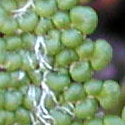 |
Cheilanthes covillei
Triangular dark green to bright green leaves in tight clusters. Leaves bipinnate to tripinnate, with beadlike leaflets. Upper surface smooth, though central leaf vein may have a few white scales. Underside heavily covered with overlapping triangular ciliate scales that are tan at first, becoming white with brown stripes. Shady cracks in granite or other igneous outcrops in shrubby desert grassland or saguaro upland. Absent from SE Arizona. SIMILAR SPECIES: C. fendleri has slightly less rounded leaf segments, scales are thinner and not ciliate. C. wootonii has larger, broader leaves and the scales do not completely cover the underside of the leaves. |
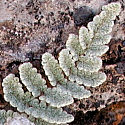 |
Cheilanthes
eatonii Leaves grayish grean, bipinnate to tripinnate, long triangular, with dense white hair above, white to tan fuzz below, and conspicuous tan scales on the underside of the stem and leaflet veins. Leaflet segments not as obviously beadlike as other Cheilanthes. Small clusters of arching fronds, part shade on steep limestone slopes. SIMILAR SPECIES: C. lindheimeri has broader leaves, rougher above and more scaly below, and grows in rows or dense stands of erect fronds. C. tomentosa is similar but leaflets are flat, never beadlike, and the underside of the stem and leaflet veins have tan or white hair, not distinct scales. |
 |
Cheilanthes
feei Triangular bright green leaves, bipinnate to tripinnate, beadlike leaflets, with scattered soft downy hairs that do not obscure the color or beaded shape of the leaflets. Segments only 1-2mm. Grows in small tufts in fractures in dry, north-facing limestone cliffs. Widespread. SIMILAR SPECIES: Smallest and most delicate-looking of the "beaded" Cheilanthes. |
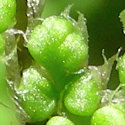 |
Cheilanthes
fendleri Light green tripinnate leaves with beadlike leaflets, green to brown stems. Upper side of leaflets smooth, underside has overlapping triangular colorless to light brown scales that do not have dark stripes. SIMILAR SPECIES: C. wootonii has darker, more heavily fringed scales and leaflet segments are more rounded. C. yavapensis is slightly downy or hairy on upper surface. C. villosa has hair on the upper surface of the leaf, and its scales have brown spots or stripes. |
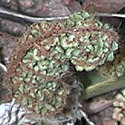 |
Cheilanthes
lendigera Light green tripinnate leaves with beadlike leaflets, dark brown stems. Upper side of leaflets slightly white-downy when young, later smooth. Underside of each leaflet segment has brown hairs on the veins and a translucent "pocket" or pouch at the margin. Range extends to Central America but in the U.S. this fern is restricted to the Mule and Huachuca Mts. Rocky oak woods and shady areas beside granite or volcanic boulders. SIMILAR SPECIES: C. fendleri, C. wootonii, and C. yavapensis look very similar, but pouches on the underside of leaflet segments are unique and are visible even when the leaf is dry and curled. |
 |
Cheilanthes
lindheimeri Fairy Sword Broad triangular grayish-green tripinnate leaves have a rough sandpapery feel. Leaflets covered in coarse dense white hair on top, tan hair underneath with light brown scales on veins. Sun to part shade, on granite or rhyolite or argillaceous rocks derived from them. Often grows in rows or dense stands, especially on granite tors or beside boulders. Also found under yucca, prickly pear, or small shrubs. One of the most common desert ferns, may be abundant in suitable habitat. SIMILAR SPECIES: Identify by broad grayish leaflets and habit of growing in large stands. |
| Cheilanthes
villosa Hairy Lip Fern Light green tripinnate triangular leaves with thin covering of white down or fuzz on upper surface. Lower surface thickly covered in overlapping white or tan scales with brown stripes. SIMILAR SPECIES: C. yavapensis has fewer and smaller scales on the underside, and scales do not have distinct stripes. C. lindheimeri is grayer, and hair on upper surface is rougher and thicker. |
|
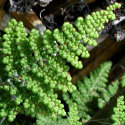 |
Cheilanthes
wootonii Triangular bright green tripinnate leaves, smooth and hairless above, with overlapping brown scales below. Often in dense clusters or stands, sun or part shade beside granite boulders or among shrubs, lechugilla, etc. Probably the most common of the "bead ferns" after C. lindheimeri. SIMILAR SPECIES: Very similar to C. yavapensis but leaves are always smooth on uppper surface. Leaves usually larger than other "bead ferns". Leaflet segments more rounded and crowded than in C. fendleri. |
 |
Cheilanthes
yavapensis Hybrid between C. lindheimeri and C. covillei. Leaves light green, triangular, tripinnate, distinctly silky or downy above, tan scaly below. Leaflet segments circular, beadlike. Part shade beside granite or volcanic rocks. SIMILAR SPECIES: Very similar to C. wootonii but leaves slightly downy or hairy on upper surface. C. feei is smaller and grows on limestone. |
| CHEILANTHES species with flat leaflets (segments not beadlike) and smooth leaves. | |
| Cheilanthes
alabamensis Smooth Lip Fern Triangular bright green leaves, tripinnate, smooth on both sides. Pinnae may be alternate. Leaflets triangular, long pointed. SIMILAR SPECIES: One of the few desert Cheilanthes that is devoid of hairs or scales on the leaves. C. wrightii is smaller, usually lighter green, with bluntly pointed leaflets. Notholaena grayi is smaller and has a white waxy coating on the underside of the leaves. |
|
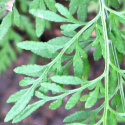 |
*Cheilanthes
arizonica Arizona Lip Fern Triangular bright green leaves, tripinnate, smooth. Segments long-oval, blunt-tipped. Resembles a member of the Parsley Family (Umbelliferae) more than a fern, but note the grooved stalk and inrolled margins on underside. Shady, wet places beside granite outcrops in a few localities near the Mexican border in southeastern AZ. SIMILAR SPECIES: C. pringlei looks superficially similar but its leaves are not as completely dissected, and leaf segments are not oval. Its range is more western and its elevation is lower (Sonoran Desert upland rather than SE sky islands). |
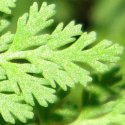 |
*Cheilanthes
pringlei Leaves bright green, tripinnate, triangular, smooth and hairless. Dense stands in damp shade in gravel at base of igneous rock outcrops, Sonoran Desert upland, among saguaros and shrubs. Uncommon. SIMILAR SPECIES: C. wrightii has broader, slightly pointed leaflets and narrower leaves. |
 |
Cheilanthes wrightii
Leaves bright green, tripinnate. Leaflets smooth on both sides, stem smooth, without scales or hairs. Leaves often die back completely in the fall. New growth appears in July with monsoon rain. Grows in tufts or small stands in full sun on granite or other igneous rock. Prefers flat areas with fine gravel and healthy soil crust. When protected from trampling, this fern may form a lacy, delicate ground cover. SIMILAR SPECIES: C. alabamensis is larger, has scaly stems, and leaflets have longer points. C. pringlei has more slender, lacy-looking leaflets, and usually prefers shadier locations. |
| CHEILANTHES species with flat leaflets (segments not beadlike) and fuzzy leaves. | |
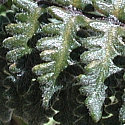 |
Cheilanthes
bonariensis (=Notholaena aurea) Golden
Lip Fern Leaves dark green, shining, narrow, long-pointed, pinnate-pinnatifid. Leaflets also narrow and long-pointed, shining, covered in fine white down on the upper surface and dense yellow feltlike fuzz on the underside. Full sun, among volcanic or granite outcrops and boulders. SIMILAR SPECIES: Notholaena aschenborniana grows on limestone and has scales and farina (not yellow fuzz) on the underside of leaflets. Astrolepis sinuata has blunt leaflets with brown scales on undersides |
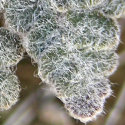 |
Cheilanthes
parryi Leaves very white-fuzzy on both sides. Leaflets bipinnate, segments round but not beaded. Grows in cracks in any kind of rock outcrop. Central and western AZ; not found in SE AZ. SIMILAR SPECIES: C. feei has beaded leaflets and leaves hairy on the back only. C. lindheimeri is larger, with longer and broader leaflets that are tan underneath. |
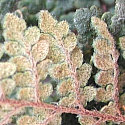 |
Cheilanthes
tomentosa Woolly Lip Fern Leaves bright green to bluish green, tripinnate. Leaflets thinly covered with short white downy hair on top, densely white to light brown fuzzy underneath. Stems and leaf veins have white or tan hairs and long, tapered tan scales. Grows in part shade among small sheltered sheltered outcrops, usually on steep slopes with good drainage. Prefers limestone but grows on any rock type. SIMILAR SPECIES: C. villosa has leaflets scaly underneath, not downy. C. eatonii has scales on stem and underside of leaf veins, and leaflet segments are more beadlike, not flat. |
 |
NOTHOLAENA
Leaves narrow triangular or star-shaped, dark green, bipinnate to pinnate-pinnatifid. Leaflets have scattered white farina (mealy grains) on upper surface, dense white farina coating on lower surface. Leaf margins are rolled under to partially cover sori. Segments at tip of leaflets are stalkless and pinnatifid. SIMILAR GENERA: The white coating on BOTH leaf surfaces is unique to this genus. Argyrochosma has white on underside of leaves only, segments at leaflet tips are stalked, and leaflets are bluish green, not dark green. |
| NOTHOLAENA species with narrow triangular leaves, bipinnate or pinnate-pinnatifid. | |
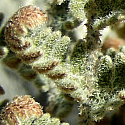 |
Notholaena
aschenborniana Dark gray-green leaves, bipinnate or pinnate-pinnatifid, long triangular. White star-shaped scales on upper surface of leaflets, brown fringed scales on lower surface and stem. White farina present on both sides, but hidden by scales. Full sun on limestone (Mississippian Escabrosa Fm), southeastern AZ. SIMILAR SPECIES: Other Notholaena have no scales on leaflets. Astrolepis are pinnate. Cheilanthes bonariensis has yellow fuzz on underside of leaflets and is not found on limestone. C. tomentosa has tripinnate leaflets with white and brownish fuzz on leaflets, not scales. |
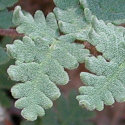 |
Notholaena
grayi Leaves bright green to dark green, bipinnate to tripinnate, triangular. Leaflets triangular. Upper side spotted with white mealy grains. Underside has scattered dark brown hairs and scales on veins. On granite or rhyolite. SIMILAR SPECIES: N. lemmonii has shorter asymmetrical leaflets that lack hairs or scales on the underside. Cheilanthes tomentosa has fuzzy leaflets, lacks white farina. |
| *Notholaena
lemmonii Leaves dark green, narrow, bipinnate. Leaflets triangular, segments variable in shape. Upper side of leaflets sparsely dotted with white mealy grains. Underside densely mealy white to pale yellow with prominent smooth brown veins, with no hairs or scales. Santa Cruz Valley, 6000-7000 feet, rare. SIMILAR SPECIES: N. grayi has longer leaflets and scattered hairs and/or scales on the veins on the underside of each leaflet. Astrolepis windhamii is scaly on the underside of the leaflets. |
|
 |
"STAR"
FERNS: Three NOTHOLAENA and two other species with pseudopentagonal
leaves. Leaves appear to be divided into five leaflets, but this is an illusion. Actually the leaf is just very short, with the lowest two pinnae as large as the rest of the leaf, and the two basal pinnules enlarged. |
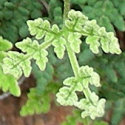 |
Notholaena
californica Leaves star-shaped, dark green when mature, bright green when young, leathery, bipinnate to tripinnate, with long stems in tight clusters. Dotted with white farina grains on upper surface, lower surface mealy white to light yellow. Dry leaves light grayish brown, curl up with underside exposed. In partially shaded cracks in granite or metamorphic rock outcrops; Middle Gila area, western AZ mountains, southern CA. SIMILAR SPECIES: N. neglecta has distinctly separate leaflet segments, grows on limestone, and its range is southeast of N. californica. N. standleyi has broader, more crowded leaflets that are less deeply divided. |
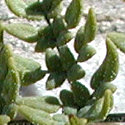 |
Notholaena
neglecta Leaves star-shaped or triangular, dark green, with triangular leaflets that are divided into discrete tiny segments. Dotted with white farina grains on upper surface, lower surface mealy white. Dry leaves curl into crescent shapes (not handlike as in other ster ferns). Partial shade on limestone outcrops, southeastern AZ mountains. SIMILAR SPECIES: N. standleyi and N. californica do not have leaves divided into tiny distinct segments, and are not limited to limestone. The range of N. californica is north and west of N. neglecta. |
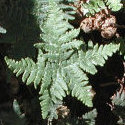 |
Notholaena
standleyi Star Fern Leaves tripinnate, dark green, leathery, long-stemmed, in tight clusters. Leaves obviously star-shaped, leaflets triangular and pointed. Upper surface of new leaves dotted with white farina grains, older leaves smooth and shining. Underside densely coated with pale yellow farina. Dry leaves tan to pale brown, curl up with underside exposed. Shade to part sun in sheltered cracks on limestone, granite, or volcanic outcrops. SIMILAR SPECIES: The most "star-like" of our ferns. Leaflets broader and more triangular than other star ferns. Pentagramma triangularis is larger, with thinner, lighter green leaves and no farina grains on upper surface. |
 |
Bommeria
hispida Copper Fern Leaves are green underneath, without any coating. Hairy on both sides. Hairs are brown on mature leaves, white on younger ones. Old leaves may turn reddish brown. Dry leaves are yellowish or purplish brown and curl down with upper surface exposed. Damp, shady areas in fractured granite or volcanic rock, beside boulders, or under shrubs, forming wandering lines of leaves from creeping rootstock. SIMILAR SPECIES: No other "star fern" in our area has hairy leaves. |
 |
Pentagramma
triangularis ssp. maxonii (= Pityrogramma triangularis)
Goldback Fern Leaves star-shaped or broadly triangular, smooth, light green, tripinnate with rounded leaflets. Underside white or pale yellow. Dry leaves dark purplish brown, curl down with upper surface exposed. Thin, bare leaves are the least adapted to desert conditions of any of our xerophytic ferns. Damp shade sandy soil in cracks or under overhangs in canyon walls, especially if sheltered by shrubs. SIMILAR SPECIES: Notholaena standleyi is darker green, more leathery, and has white farina grains on the upper surface. |
